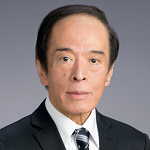Wednesday, Oct 23, 2024 | 03:00 PM - 03:25 PM
Location: Cedar Hall HQ1-1-660
![]() Click here for the photos
Click here for the photos
OVERVIEW
In 2024, the Bank of Japan (BOJ) discontinued the policy framework known as Quantitative and Qualitative Monetary Easing with Yield Curve Control, and raised the policy interest rate for the first time since 2007. Now that changes in firms' wage- and price-setting behavior have become more evident, the BOJ projects that, in the second half of the projection period of the latest Outlook Report, underlying inflation is likely to be at a level that is generally consistent with the price stability target of two percent. Of course, there are a variety of both upside and downside risks. APD Director Krishna Srinivasan will be joined by the BOJ Governor Kazuo Ueda to discuss where Japan’s inflation and monetary policy are.
REPORT
Key Points:
Quote:
“To answer in a very theoretical way, I think about what would be the right size of normalization, in total, going forward, and how best to allocate that total rate hike across time optimally. That keeps me awake 24/7”. Kazuo Ueda
Contributor: Paris Gkartzonikas
SPEAKER

Kazuo Ueda
Governor of the Bank of Japan
Dr. Kazuo Ueda was appointed Governor of the Bank of Japan in April 2023.
He started his career as an assistant professor in the Department of Economics at the University of British Columbia in 1980. In 1982, he became an associate professor at Osaka University, and in 1993 he became a professor at the University of Tokyo, specializing in macroeconomics and financial theory. From 1998 to 2005, he was a member of the Bank of Japan's Policy Board, the central bank's highest decision-making body, where he led discussions on the introduction of forward guidance under the Bank's zero interest rate policy. After completing the term of the Policy Board member, he became a professor at the Graduate School of Economics at the University of Tokyo in 2005 (serving as dean from 2005 to 2007). In 2017, he became a professor at Kyoritsu Women's University. He was awarded the title of Professor Emeritus from the University of Tokyo in 2017 and from Kyoritsu Women's University in 2023.
Apart from his academic roles, Dr. Ueda also served as an external member of the Board of Directors at the Development Bank of Japan from 2008 to 2023. He also chaired the Investment Committee of Japan's Government Pension Investment Fund (GPIF) from 2010 to 2014. From 2011 to 2012, he was President of the Japanese Economic Association.
Born in September 1951, Dr. Ueda holds a Bachelor of Science in Mathematics from the University of Tokyo (1974) and a Doctor of Philosophy in Economics from the Massachusetts Institute of Technology (1980).
MODERATOR

Krishna Srinivasan
Director of the Asia and Pacific Department
Krishna Srinivasan is the Director of the Asia and Pacific Department (APD). In this- capacity, he will oversee the institution’s work on all countries in the Asia-Pacific region. He was previously a Deputy Director in APD, overseeing the work on several systemically important countries, including China and Korea. Prior to that, Krishna was a Deputy Director in the Western Hemisphere Department (WHD), where he oversaw the institution’s work on several countries in the Americas, including Brazil, Canada, Mexico, Peru, Ecuador and the island economies of the Caribbean, the department’s research activities, and its flagship product, Regional Economic Outlook (REO) for Latin America and the Caribbean. He is a co-editor of two recent books: Brazil—Boom, Bust and the Road to Recovery; and Unleashing Growth and Strengthening Resilience in the Caribbean. Before joining WHD, Krishna was the IMF’s mission chief for the United Kingdom and Israel, when he was a staff member of the European Department, and before that in the Research Department, where he led the IMF’s work on the G-20 in the context of the global financial crisis. In the context of this work, he and was the editor of an IMF book Global Rebalancing: A Roadmap for Economic Recovery. Krishna has been with the IMF since 1994 and has served in several departments across the institution. He secured his PhD in International Finance from Indiana University and a Master’s from the Delhi School of Economics, India, and has published several papers both at the IMF and in leading academic journals.